
The term antelope refers to numerous extant or recently extinct species of the ruminant artiodactyl family Bovidae that are indigenous to most of Africa, India, the Middle East, Central Asia, and a small area of Eastern Europe. Antelopes do not form a monophyletic group, as some antelopes are more closely related to other bovid groups, like bovines, goats, and sheep, than to other antelopes.

Bovines comprise a diverse group of 10 genera of medium to large-sized ungulates, including cattle, bison, African buffalo, water buffalos, and the four-horned and spiral-horned antelopes. The evolutionary relationship between the members of the group is still debated, and their classification into loose tribes rather than formal subgroups reflects this uncertainty. General characteristics include cloven hooves and usually at least one of the sexes of a species having true horns. The largest extant bovine is the gaur.

The subfamily Caprinae, also sometimes referred to as the tribe Caprini, is part of the ruminant family Bovidae, and consists of mostly medium-sized bovids. A member of this subfamily is called a caprine.

The Bovidae comprise the biological family of cloven-hoofed, ruminant mammals that includes cattle, yaks, bison, buffalo, antelopes, sheep and goats. A member of this family is called a bovid. With 143 extant species and 300 known extinct species, the family Bovidae consists of 11 major subfamilies and thirteen major tribes. The family evolved 20 million years ago, in the early Miocene.

The four-horned antelope, or chousingha, is a small antelope found in India and Nepal. Its four horns distinguish it from most other bovids, which have two horns. The sole member of the genus Tetracerus, the species was first described by French zoologist Henri Marie Ducrotay de Blainville in 1816. Three subspecies are recognised. The four-horned antelope stands nearly 55–64 centimetres (22–25 in) at the shoulder and weighs nearly 17–22 kilograms (37–49 lb). Slender with thin legs and a short tail, the four-horned antelope has a yellowish brown to reddish coat. One pair of horns is located between the ears, and the other on the forehead. The posterior horns are always longer than the anterior horns, which might be mere fur-covered studs. While the posterior horns measure 8–12 centimetres (3.1–4.7 in), the anterior ones are 2–5 centimetres (0.79–1.97 in) long.
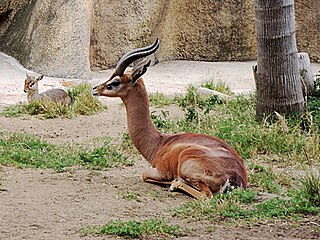
The gerenuk, also known as the giraffe gazelle, is a long-necked, medium-sized antelope found in parts of East Africa. The sole member of the genus Litocranius, the gerenuk was first described by the naturalist Victor Brooke in 1879. It is characterised by its long, slender neck and limbs. The antelope is 80–105 centimetres tall, and weighs between 18 and 52 kilograms. Two types of colouration are clearly visible on the smooth coat: the reddish brown back or the "saddle", and the lighter flanks, fawn to buff. The horns, present only on males, are lyre-shaped. Curving backward then slightly forward, these measure 25–44 cm.
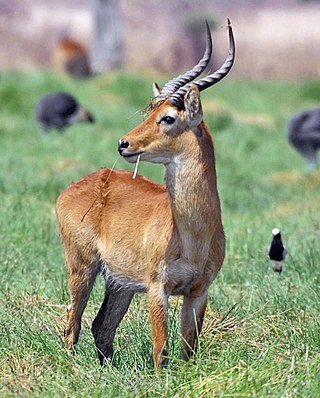
The puku is a medium-sized antelope found in wet grasslands in southern Democratic Republic of Congo, Namibia, Tanzania, Zambia and more concentrated in the Okavango Delta in Botswana. Nearly one-third of all puku are found in protected areas, zoos, and national parks due to their diminishing habitat.

A horn is a permanent pointed projection on the head of various animals that consists of a covering of keratin and other proteins surrounding a core of live bone. Horns are distinct from antlers, which are not permanent. In mammals, true horns are found mainly among the ruminant artiodactyls, in the families Antilocapridae (pronghorn) and Bovidae. Cattle horns arise from subcutaneous connective tissue and later fuse to the underlying frontal bone.

The royal antelope is a West African antelope recognized as the world's smallest. It was first described by Swedish zoologist Carl Linnaeus in 1758. It stands up to merely 25 cm (10 in) at the shoulder and weighs 2.5–3 kg (5.5–6.6 lb). A characteristic feature is the long and slender legs, with the hindlegs twice as long as the forelegs. Horns are possessed only by males; the short, smooth, spiky horns measure 2.5–3 cm (0.98–1.18 in) and bend backward. The soft coat is reddish to golden brown, in sharp contrast with the white ventral parts. In comparison to Bates's pygmy antelope, the royal antelope has a longer muzzle, broader lips, a smaller mouth and smaller cheek muscles.

Myotragus is an extinct genus of goat-antelope in the tribe Caprini which lived on the Balearic Islands of Mallorca and Menorca in the western Mediterranean until its extinction around 4,500 years ago. The fossil record of Myotragus on the Balearic Islands extends over 5 million years back to the early Pliocene on Mallorca, where it presumably arrived after the evaporation of the Mediterranean Sea during the Messinian Salinity Crisis.

The suni is a small antelope of the family Bovidae, and one of the smallest ungulates on earth. It occurs in dense underbrush from central Kenya to KwaZulu-Natal in South Africa. It is also found on the island of Zanzibar off of Tanzania.
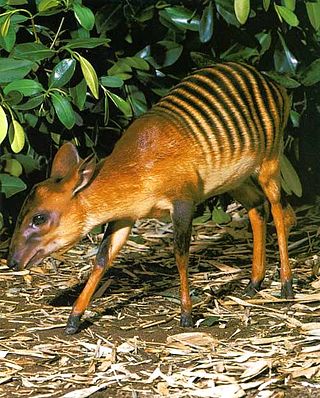
The zebra duiker is a small antelope found primarily in Liberia, as well as the Ivory Coast, Sierra Leone, and occasionally Guinea. They are sometimes referred to as the banded duiker or striped-back duiker. It is believed to be one of the earliest duiker species to have evolved.
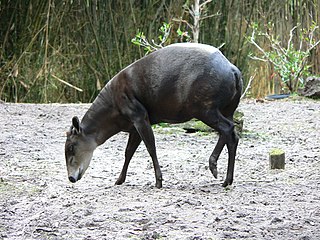
The yellow-backed duiker is a shy, forest-dwelling antelope of the order Artiodactyla, from the family Bovidae. Yellow-backed duikers are the most widely-distributed of all duikers. They are found mainly in Central and Western Africa, ranging from Senegal and Gambia on the western coast, through to the Democratic Republic of the Congo to western Uganda; their distribution continues southward into Rwanda, Burundi, and most of Zambia.

Candiacervus is an extinct genus of deer native to Pleistocene Crete. Due to a lack of other herbivores, the genus underwent an adaptive radiation, filling niches occupied by other taxa on the mainland. Due to the small size of Crete, some species underwent insular dwarfism, the smallest species, C. ropalophorus, stood about 40 centimetres (16 in) at the shoulders when fully grown, while other species were relatively large and comparable in size to mainland deer species. Some species are noted for their peculiar, elongate club-shaped antlers, though other species have more normal antlers.

The tribe Bovini or wild cattle are medium to massive bovines that are native to Eurasia, North America, and Africa. These include the enigmatic, antelope-like saola, the African and Asiatic buffalos, and a clade that consists of bison and the wild cattle of the genus Bos. Not only are they the largest members of the subfamily Bovinae, they are the largest species of their family Bovidae. The largest species is the gaur, weighing up to 1,500 kg (3,300 lb).

The tribe Tragelaphini, or the spiral-horned antelopes, are bovines that are endemic to sub-Saharan Africa. These include the bushbucks, kudus, and the elands. The scientific name is in reference to the mythical creature the tragelaph, a Chimera with the body of a stag and the head of a goat. They are medium-to-large, tall, long-legged antelopes characterized by their iconic twisted horns and striking pelage coloration patterns.
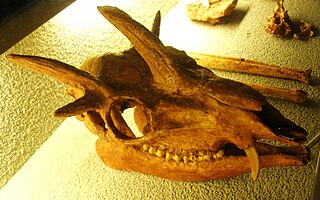
Hoplitomeryx is a genus of extinct deer-like ruminants which lived on the former Gargano Island during the Miocene and the Early Pliocene, now a peninsula on the east coast of South Italy. Hoplitomeryx, also known as "prongdeer", had five horns and sabre-like upper canines similar to a modern musk deer.

Bovidae in Chinese mythology include various myths and legends about a group of biologically distinct animals which form important motifs within Chinese mythology. There are many myths about the animals modernly classified as Bovidae, referring to oxen, sheep, goats, and mythological types such as "unicorns". Chinese mythology refers to those myths found in the historical geographic area of China, a geographic area which has evolved or changed somewhat through history. Thus this includes myths in Chinese and other languages, as transmitted by Han Chinese as well as other ethnic groups. There are various motifs of animals of the Bovidae biological family in Chinese mythology. These have often served as allusions in poetry and other literature. Some species are also used in the traditional Chinese calendar and time-keeping system.

Goat evolution is the process by which domestic goats came to exist through evolution by natural selection. Wild goats — medium-sized mammals which are found in noticeably harsh environments, particularly forests and mountains, in the Middle East and Central Asia — were one of the first species domesticated by modern humans, with the date of domestication generally considered to be 8,000 BCE. Goats are part of the family Bovidae, a broad and populous group which includes a variety of ruminants such as bison, cows and sheep. Bovids all share many traits, such as hooves and a herbivorous diet and all males, along with many females, have horns. Bovids began to diverge from deer and giraffids during the early Miocene epoch. The subfamily Caprinae, which includes goats, ibex and sheep, are considered to have diverged from the rest of Bovidae as early as the late Miocene, with the group reaching its greatest diversity in the ice ages.
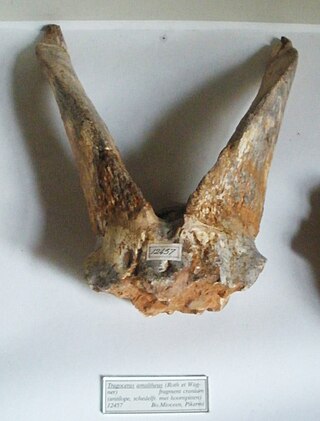
Tragoportax is an extinct genus of bovid ungulate. It lived during the upper Miocene, and its fossils have been found in Europe, Asia and Africa. Tragoportax is sometimes considered to have been a close relative of the extant nilgai, though it may have formed its own subfamily, along with Miotragocerus.




















